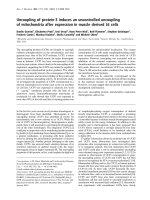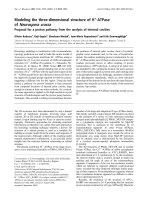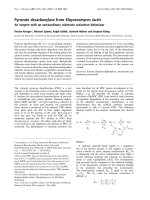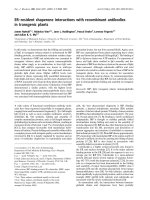Báo cáo y học: " Circumferential thoracolumbar corrective fusion with an anterior interbody fresh-frozen femoral head allograft for osteoporotic lower acute kyphosis: a case report" ppt
Bạn đang xem bản rút gọn của tài liệu. Xem và tải ngay bản đầy đủ của tài liệu tại đây (577.09 KB, 4 trang )
BioMed Central
Page 1 of 4
(page number not for citation purposes)
Journal of Medical Case Reports
Open Access
Case report
Circumferential thoracolumbar corrective fusion with an anterior
interbody fresh-frozen femoral head allograft for osteoporotic
lower acute kyphosis: a case report
Naohisa Miyakoshi*
1
, Eiji Abe
2
and Yoichi Shimada
1
Address:
1
Division of Orthopedic Surgery, Department of Neuro and Locomotor Science, Akita University School of Medicine, 1-1-1 Hondo, Akita
010-8543, Japan and
2
Department of Orthopedic Surgery, Akita Kumiai General Hospital, 1-1-1 IIjima-Nishibukuro, Akita 011-0948, Japan
Email: Naohisa Miyakoshi* - ; Eiji Abe - ; Yoichi Shimada -
* Corresponding author
Abstract
Introduction: Lower acute kyphosis (LAK) is a postural deformity caused by severe osteoporotic
vertebral collapse at the thoracolumbar junction. Corrective surgery is indicated for severe cases,
but no case report using a fresh-frozen femoral head allograft was found in the English literature.
Case presentation: A 69-year-old Japanese woman with severe LAK with osteoporotic vertebral
fractures from T11 to L2 complained of severe back pain and difficulty in walking. The rigid kyphosis
measured 74° from T10 to L3. The patient underwent an anterior release and interbody fusion
using a fresh-frozen femoral head allograft (T11-L3) and a posterior instrumented fusion (T10-L3).
Postoperatively, kyphosis was corrected to 28°, and the patient's symptoms were alleviated. The
allograft bone was fully incorporated 1 year postoperatively. A new vertebral fracture at T10
occurred after 2 years, resulting in a slight loss of correction. A kyphosis angle of 35° at 2 years
was maintained at 12 years (age, 81 years). She remained free of back pain and able to walk without
a cane over the 12-year follow-up.
Conclusion: For treatment of severe osteoporotic LAK, anterior reconstruction is essential to
obtain good spinal alignment and prevent recurrence. A fresh-frozen femoral head allograft, in
combination with rigid posterior instrumented fixation, fulfills this function.
Introduction
Lower acute kyphosis, resulting in localized kyphosis of
the thoracolumbar junction with compensative thoracic
lordosis, is one of the postural deformities caused by
severe osteoporotic vertebral fractures at the thoracolum-
bar junction [1]. Lower acute kyphosis is less common
compared with other osteoporotic postural deformities,
such as round back and hollow round back, and may be
rare in Western countries; however, it is often seen in
Asian countries, including Japan. The weakness of lumbar
back muscles associated with this deformity leads to addi-
tional deterioration [2]. Elderly Asian women who work
in forward-bending postures are predisposed to weakness
of the lumbar back muscles with degeneration and atro-
phy [3,4]. This deformity causes severe back pain at the
apex of the kyphosis and impairs physical activity and
quality of life (QOL) [1]. Corrective surgery is indicated
for severe cases, but no case report using a fresh-frozen
femoral head allograft was found in the English literature.
We report a case showing excellent surgical outcome at the
Published: 19 November 2009
Journal of Medical Case Reports 2009, 3:137 doi:10.1186/1752-1947-3-137
Received: 19 September 2009
Accepted: 19 November 2009
This article is available from: />© 2009 Miyakoshi et al; licensee BioMed Central Ltd.
This is an Open Access article distributed under the terms of the Creative Commons Attribution License ( />),
which permits unrestricted use, distribution, and reproduction in any medium, provided the original work is properly cited.
Journal of Medical Case Reports 2009, 3:137 />Page 2 of 4
(page number not for citation purposes)
12-year follow-up after circumferential thoracolumbar
fusion with an anterior interbody fresh-frozen femoral
head allograft for lower acute kyphosis.
Case presentation
A 69-year-old Japanese woman with osteoporosis and
lower acute kyphosis was referred to our hospital com-
plaining of severe back pain and difficulty in walking. The
patient's physical examination demonstrated an obvious
thoracolumbar kyphosis with a normal, lower extremity
neurologic status. Back pain worsened in intensity and fre-
quency during standing and walking and did not respond
to treatment with pharmacotherapy, bracing, or trigger
point injections. Protruded spinous processes of the apex
with back muscle atrophy resulted in irritated skin, and
the patient could not lie on her back. Radiography of total
spine showed severe lower acute kyphosis with oste-
oporotic vertebral fractures of T11, T12, L1, and L2 (Fig.
1). The kyphosis was rigid, measuring 70° from T11 to L2,
and correcting to 67° on hyperextension. The kyphosis at
the upright position from T10-L3 was 74°.
The patient met the criteria for surgery and underwent an
anterior release and interbody fusion followed by a poste-
rior instrumented fusion. A left side extrapleural-retro-
peritoneal approach with T11 rib resection, anterior
spinal release, discectomies, and interbody bone grafting
were performed from T11 to L3. For interbody fusion,
Harms Cage (DePuy Spine, Raynham, MA, USA) and har-
vested autograft T11 rib were used for T12-L1 level and
15-mm slices of fresh-frozen femoral head allograft were
used for T11-T12, L1-L2, and L2-L3. The fresh-frozen fem-
oral head allograft was obtained from living donors who
had undergone total hip arthroplasty. The posterior
instrumented spinal fusion using CD System (Medtronic
Sofamor Danek, Memphis, TN, USA) was performed from
T10 to L3. Partial facetectomies were performed at each
level. Transpedicular fixation was obtained bilaterally
from T11 to L3. Downgoing transverse process hooks
were placed bilaterally at T10, and upgoing laminar hooks
were placed bilaterally at L3. Bone chips from the femoral
head allograft mixed with resected spinous processes were
grafted posteriorly. Postoperatively, kyphosis was cor-
rected to 28°, as measured from T10 to L3. Symptoms
were alleviated after surgery.
A thoracolumbar brace was applied for 6 months. Inter-
body solid fusion from T11 to L3 with incorporation of
the femoral head allograft was seen by 1 year postopera-
tively. A new vertebral fracture of T10 occurred 2 years
postoperatively, resulting in a slight loss of correction
(35°, T10-L3). However, no additional vertebral fractures
occurred thereafter. After surgery, the patient started oste-
oporosis pharmacotherapy with alfacalcidol (1 μg/day)
for 5 years, followed by alendronate (5 mg/day) or risedr-
onate (2.5 mg/day) until present. Kyphosis corrected to
35° 2 years postoperatively (Fig. 2) was maintained at the
patient's 12-year follow-up evaluation (Fig. 3). She
remained free of back pain and able to walk without a
cane at her 12-year follow-up (age, 81 years).
Discussion
Severe osteoporotic lower acute kyphosis is a rare spinal
disorder that impairs a patient's physical activity and QOL
due to intolerable back pain and difficulty in walking. Spi-
nal sagittal malalignment, showing obvious local kypho-
sis at the thoracolumbar junction (caused by severe
vertebral collapse) and back muscle weakness, induce
additional fractures, resulting in progressive angular
kyphosis. Surgical spinal correction is indicated to reduce
the patient's symptoms. In the elderlies, less invasive sur-
geries such as vertebroplasty and kyphoplasty are gener-
ally recommended for osteoporotic spine. However,
vertebroplasty or kyphoplasty alone cannot correct the
rigid spinal kyphosis. From a mechanical point of view, an
anterior-column injury should be approached anteriorly
[5]. For the treatment of severe osteoporotic lower acute
kyphosis, anterior release and anterior support recon-
struction is important to obtain good spinal alignment
and prevent recurrence.
Preoperative standing lateral radiography of the spine show-ing osteoporosis and severe lower acute kyphosis (obvious thoracolumbar kyphosis with thoracic lordosis)Figure 1
Preoperative standing lateral radiography of the
spine showing osteoporosis and severe lower acute
kyphosis (obvious thoracolumbar kyphosis with tho-
racic lordosis).
Journal of Medical Case Reports 2009, 3:137 />Page 3 of 4
(page number not for citation purposes)
A femoral cortical ring allograft (femoral shaft allograft) is
commonly used for anterior interbody fusions in Western
countries [6,7]. However, the allograft, especially cortical
bone of the femoral ring, requires at least 18 months
before most cortical bone allografts are fully incorporated
into the host bone [6]. In addition, the cortical ring may
be mechanically too strong for the osteoporotic vertebrae.
The subsidence of an implanted material is generally
caused by a loss of strength at the implant-vertebral bone
junction [8].
A fresh-frozen femoral head allograft fulfills its desired
function as an anterior structural graft in combination
with rigid posterior transpedicular fixation, maintaining
the disk space height achieved at surgery while allowing
remodeling and incorporation into a solid anterior fusion
[9]. Advantages of this allograft include initial biome-
chanical stiffness and correction and maintenance of any
deformities. In addition, the increased area of surface con-
tact between the allograft and adjacent vertebral body and
the placement of the graft under compression improve
stability and allow early axial loading. Bendo et al. [9]
evaluated 50 cases that underwent lumbar interbody
fusions for non-osteoporotic lumbar degenerative dis-
eases with anterior fresh-frozen femoral head allograft as
a structural interbody graft material with a mean follow-
up of 28 months. Ninety percent of their cases were one-
or two-level fusions. In their series, the average time to
anterior radiographic fusion was 6 months (range, 4 to 8
months) without correction loss, and the overall fusion
rate was 98% [9]. Compared with autogenous bone graft,
the lower incorporation and fusion rates of allografts are
well known, but the fusion time of the femoral head allo-
graft [9] is shorter than the femoral cortical ring allograft
[6].
In Japan, allograft bone grafting is not popular because
allograft bones are not commercially available. However,
in our case, we could use a fresh-frozen femoral head allo-
graft from living donors who had undergone total hip
arthroplasty and obtained excellent long-term outcome.
Conclusion
For treatment of severe osteoporotic LAK, anterior recon-
struction is essential to obtain good spinal alignment and
prevent recurrence. A fresh-frozen femoral head allograft,
in combination with rigid posterior instrumented fixa-
tion, fulfills this function. Excellent surgical outcome
without correction loss was maintained over 12 years in
the present case.
Standing lateral radiography of the spine obtained 2 years after surgeryFigure 2
Standing lateral radiography of the spine obtained 2
years after surgery. Good correction was obtained.
Standing lateral radiography of the spine obtained 12 years after surgeryFigure 3
Standing lateral radiography of the spine obtained 12
years after surgery. No correction loss was observed up
to final follow-up.
Publish with BioMed Central and every
scientist can read your work free of charge
"BioMed Central will be the most significant development for
disseminating the results of biomedical research in our lifetime."
Sir Paul Nurse, Cancer Research UK
Your research papers will be:
available free of charge to the entire biomedical community
peer reviewed and published immediately upon acceptance
cited in PubMed and archived on PubMed Central
yours — you keep the copyright
Submit your manuscript here:
/>BioMedcentral
Journal of Medical Case Reports 2009, 3:137 />Page 4 of 4
(page number not for citation purposes)
Abbreviations
LAK: lower acute kyphosis.
Consent
Written informed consent was obtained from the patient
for publication of this case report and accompanying
images. A copy of the written consent is available for
review by the Editor-in-Chief of this journal.
Competing interests
The authors declare that they have no competing interests.
Authors' contributions
The authors were involved in the writing of the manu-
script and patient clinical care. All authors read and
approved the final manuscript.
References
1. Miyakoshi N, Itoi E, Kobayashi M, Kodama H: Impact of postural
deformities and spinal mobility on quality of life in postmen-
opausal osteoporosis. Osteoporos Int 2003, 14:1007-1012.
2. Miyakoshi N, Hongo M, Maekawa S, Ishikawa Y, Shimada Y, Itoi E:
Back extensor strength and lumbar spinal mobility are pre-
dictors of quality of life in patients with postmenopausal
osteoporosis. Osteoporos Int 2007, 18:1397-1403.
3. Lee CS, Lee CK, Kim YT, Hong YM, Yoo JH: Dynamic sagittal
imbalance of the spine in degenerative flat back: significance
of pelvic tilt in surgical treatment. Spine 2001, 26:2029-2035.
4. Takemitsu Y, Harada Y, Iwahara T, Miyamoto M, Miyatake Y: Lum-
bar degenerative kyphosis. Clinical, radiological and epide-
miological studies. Spine 1988, 13:1317-1326.
5. Kaneda K, Asano S, Hashimoto T, Satoh S, Fujiya M: The treatment
of osteoporotic-posttraumatic vertebral collapse using the
Kaneda device and a bioactive ceramic vertebral prosthesis.
Spine 1992, 17(8 Suppl):S295-303.
6. Chotivichit A, Fujita T, Wong TH, Kostuik JP, Sieber AN: Role of
femoral ring allograft in anterior interbody fusion of the
spine. J Orthop Surg (Hong Kong) 2001, 9:1-5.
7. Watkins RG, Hussain N, Freeman BJ, Grevitt MP, Webb JK: Ante-
rior instrumentation for thoracolumbar adolescent idio-
pathic scoliosis: do structural interbody grafts preserve
sagittal alignment better than morselized rib autografts?
Spine 2006, 31:2337-2342.
8. Uchida K, Kobayashi S, Nakajima H, Kokubo Y, Yayama T, Sato R, et
al.: Anterior expandable strut cage replacement for oste-
oporotic thoracolumbar vertebral collapse. J Neurosurg Spine
2006, 4:454-462.
9. Bendo JA, Spivak JM, Neuwirth MG, Chung P: Use of the anterior
interbody fresh-frozen femoral head allograft in circumfer-
ential lumbar fusions. J Spinal Disord 2000, 13:144-149.





![Báo cáo Y học: Effect of adenosine 5¢-[b,c-imido]triphosphate on myosin head domain movements Saturation transfer EPR measurements without low-power phase setting ppt](https://media.store123doc.com/images/document/14/rc/vd/medium_vdd1395606111.jpg)



